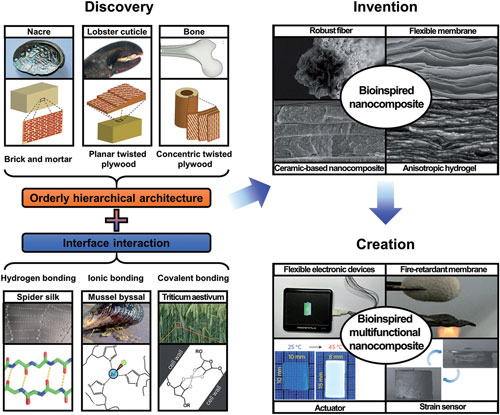| Posted: Nov 10, 2017 | |
Nanotechnology materials inspired by nature |
|
| (Nanowerk Spotlight) The remarkable properties of some natural materials have motivated many researchers to synthesize biomimetic nanocomposites and other nanostructured materials that attempt to reproduce Nature’s achievements. | |
| Nanotechnology researchers involved in improving man-made composite materials are trying to understand how some of the amazing high-performance materials found in Nature can be copied or even improved upon. Already we have seen biomimetic water-pinning nanostructures, high-performing nanocomposite materials inspired by mussels and seashells, a method for tissue regeneration inspired by nature, even a bio-inspired approach to making sustainable cement. | |
| Nature has evolved complex bottom-up methods for fabricating ordered nanostructured materials that often have extraordinary mechanical strength and toughness. Apart from bone and lobster cuticle, one of the best examples is nacre, the pearly internal layer of many mollusc shells. It has evolved through millions of years to a level of optimization currently achieved in very few engineered composites. | |
| Recent research has indicated that the amplification of natural materials' mechanical properties far beyond those of the components that comprise them originates mainly from: 1) a hierarchical micro-/nanoscale architecture and 2) abundant effective interface interactions. | |
| In a recent progress report in Advanced Materials ("High-Performance Nanocomposites Inspired by Nature"), Jingsong Peng and Qunfeng Cheng from the Key Laboratory of Bio-Inspired Smart Interfacial Science at Beihang University, follow the roadmap of 'discovery, invention, and creation', as shown in the figure below, to provide insight into the development of bio-inspired structural materials. | |
 |
|
| Development of structural materials – discovery, invention, and creation. In the “discovery” section, natural materials are clarified as the source of inspiration. Next, bio-inspired robust nanocomposites are summarized and basic principles’ effect illustrated in the “invention” section. Finally, the “creation” section reviews multifunctional nanocomposites. (click on image to enlarge) | |
| In the discovery section, natural materials are described as a source of inspiration. Bio-inspired nanocomposites can be invented to mimic or even to surpass natural materials' attributes, as described in the invention section. The scientists illustrate how the basic principles could work for bio-inspired nanocomposites with different building blocks and fabrication approaches. Finally, in the creation section, they review novel multifunctional nanocomposites with properties that natural materials rarely possess. | |
| To provide a vision and inspiration for future research, the authors conclude with their perspectives on new and promising directions in the field, along with problems remaining to be solved. | |
Discovery: Natural Materials |
|
| Insight into the architecture of a typical natural material is the key to understanding the superiority of the biomimetic strategy for making novel synthetic materials. Here, the scientists discuss in detail the orderly hierarchical architectures of nacre, bone and lobster cuticle. | |
| An orderly hierarchical architecture is the foundation of how natural materials behave when loaded or fractured. The accumulated evidence shows that the interface interactions that join the various building blocks at different levels of hierarchy largely govern the deformation. Therefore, clarifying interface interactions of natural materials is essential and the authors discuss these issues as well. | |
Invention: Bio-inspired Structural Materials |
|
| In this section, the two scientists detail how the earlier-described principles primarily responsible for some natural materials' exceptional properties – a hierarchical micro-/nanoscale architecture and abundant effective interface interactions – could be used to design novel bio-inspired structural materials. | |
| This involves either mimicking the natural architecture (e.g. emulating nacre’s brick-and-mortar structure to build tough ceramic-based composites) or extending bio-inspired fabrication (bio-inspired strategies have also been extended to all kinds of composites, including 1D fiber, 2D film, and 3D bulk composites). | |
Creation: Bio-inspired Multifunctional Materials |
|
| With the quest to develop new functional devices, such as wearable electronic devices, intelligent responsive devices, and actuators, multifunctional materials integrating robust mechanical properties as well as other functions are urgently needed. | |
| In this section, the authors review a series of robust bio-inspired nanocomposites integrating other functions, providing a blueprint for the broad applications of bio-inspired nanocomposites. They discuss nanogenerators, electrical conductors, supercapacitors, actuators, strain sensors, and fire retardancy. | |
Outlook |
|
| Although many high-performance bio-inspired structural nanocomposites with excellent multifunctional properties are being fabricated, the advantageous features of natural materials are still difficult to surpass, especially with functions such as self-healing, recycling, and external adaptation. | |
| In addition, progress is hindered by the lack of large-scale fabrication methods and a well-designed approach to mimic the architecture of different hierarchies simultaneously. | |
| "Despite extensive recent work, research on bio-inspired structural nanocomposites urgently needs to exploit novel fabrication and nondestructive characterization approaches on a large scale to advance the development of synthetic materials closely mimicking natural materials," the authors conclude their report. "Future efforts in mimicking natural materials should be guided by the development and modeling of novel processing techniques and by first principles and microscale mechanics modeling of how properties are related to the structure and the nature of the interfaces the material contains." | |
 By
Michael
Berger
– Michael is author of three books by the Royal Society of Chemistry:
Nano-Society: Pushing the Boundaries of Technology,
Nanotechnology: The Future is Tiny, and
Nanoengineering: The Skills and Tools Making Technology Invisible
Copyright ©
Nanowerk LLC
By
Michael
Berger
– Michael is author of three books by the Royal Society of Chemistry:
Nano-Society: Pushing the Boundaries of Technology,
Nanotechnology: The Future is Tiny, and
Nanoengineering: The Skills and Tools Making Technology Invisible
Copyright ©
Nanowerk LLC
|
|
|
Become a Spotlight guest author! Join our large and growing group of guest contributors. Have you just published a scientific paper or have other exciting developments to share with the nanotechnology community? Here is how to publish on nanowerk.com. |
|
